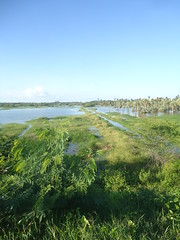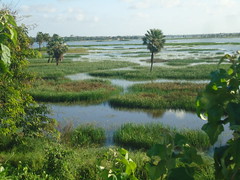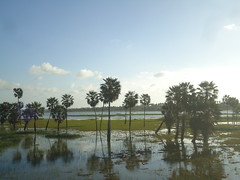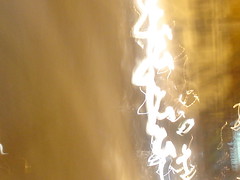Fortaleza
Fortaleza (Portuguese: [foʁtaˈlezɐ], Portuguese for Fortress) is the state capital of Ceará, located in Northeastern Brazil. It is Brazil's 5th largest city, with a population of slightly over 2.7 million, and the 12th largest city by gross domestic product. It forms the core of the Fortaleza metropolitan area, which is home to over 4.1 million people.
Fortaleza is an important industrial and commercial center of Northeast Brazil. According to the Ministry of Tourism, it is the fourth most visited city and tourist destination in the country. The BR-116, the most important highway of the country, starts in Fortaleza. The municipality is part of the Mercosur common market, and vital trade port which is closest to mainland Europe, being from Lisbon, Portugal.
To the north of the city lies the Atlantic Ocean; to the south are the municipalities of Pacatuba, Eusébio, Maracanaú and Itaitinga; to the east is the municipality of Aquiraz and the Atlantic Ocean; and to the west is the municipality of Caucaia. Residents of the city are known as Fortalezenses. Fortaleza, along with Recife and Salvador, is a considered one of the primate cities of Northeast Region.
History
Colonial period
Colonisation began in 1603 when Portugal was part of the Iberian Union, when the Portuguese Pero Coelho de Souza constructed the Fort of São Tiago and founded the settlement of Nova Lisboa (New Lisbon). After a victory over the French in 1612, Martins Soares Moreno expanded the Fort of São Tiago and changed its name to Forte de São Sebastião.
In 1630 the Dutch invaded the Brazilian Northeast and in 1637 they took the Fort of São Sebastião and ruled over Ceará. In battles with the Portuguese and natives in 1644 the fort was destroyed. Under captain Matthias Beck the Dutch West Indies Company built a new fortress by the banks of river Pajeú. Fort Schoonenborch ("graceful stronghold") officially opened on August 19, 1649. After the capitulation of Pernambuco in 1654, the Dutch handed over this fortress to the Portuguese, who renamed it Fortaleza da Nossa Senhora de Assunção ("Fort of Our Lady of the Assumption"), after which the city of Fortaleza takes its name.
Fortaleza was officially founded as a village 1726, becoming the capital of Ceará state in 1799.
Imperial period
During the 19th century, Fortaleza was consolidated as an urban centre in Ceará, supported by the cotton industry. With the transformation of the city into a regional export center and with the increase of direct navigation to Europe, the customs building of Fortaleza was built in 1812. In 1824, the city was targeted by the revolutionaries of Confederation of the Equator.
Republican period
The city gained a number of new districts in the 1930s, including Messejana and Porangaba. In 1954, the first university in the city was created, the Universidade Federal do Ceará (UFC).
In 1983 the city started to integrate the territory of the new city of Maracanaú, which, just some years ago, was made again part of the Greater Fortaleza (the city's Metropolitan area). In the 1980s, Fortaleza exceeded Recife in population terms, becoming the second most populous city in Northeastern Brazil, with 2,571,896 inhabitants.
Geography
Vegetation
In Fortaleza there are some remaining areas of mangrove in preserved areas, including Cocó Park. Ten miles offshore is the Pedra da Risca do Meio Marine State Park, created in 1997 to protect the reefs.
Ecology and environment
The vegetation of Fortaleza is typically coastal. The restinga areas are found in dune regions near the mouths of the Ceará, Cocó and Pacoti rivers, in the beds of which there is still a mangrove forest. In other green areas of the city, there is no longer native vegetation, consisting of varied vegetation, fruit trees more commonly. The city is home to seven environmental conservation units. These are the Sabiaguaba Dunes Municipal Natural Park, the Sabiaguaba Environmental Protection Area, the Maraponga Lagoon Ecological Park, the Cocó Ecological Park, the Ceará River Estuary Environmental Protection Area, the Environmental Protection Area of the Rio Pacoti and the Pedra da Risca do Meio Marine State Park. There is also, in the city, the Area of Relevant Ecological Interest of Sírio Curió, that protects the last enclave of Atlantic Forest in the urban zone.
The Cocó River is part of the river basin of the east coast of Ceará and has a total length of about 50 km in its main area. The park is inserted in the area of greater environmental sensitivity of the city, where it is possible to identify geoenvironmental formations such as coastal plain, fluvial plain and surface of the coastal trays. The Cocó river mangrove is home to mollusks, crustaceans, fish, reptiles, birds and mammals. The park has a structure of visitation, with guides, ecological trails and equipment and events of environmental education and ecotourism. The Coaçu River, affluent of the river Cocó, forms in its bed the lagoon of the Precabura.
The Rio Pacoti provides much of the water supply for Fortaleza. At the municipal boundary with Caucaia, the estuary of the Rio Ceará is covered by an environmental protection area (APA), which was set up in 1999.
Demographics
According to the 2010 IBGE Census, there were 2,315,116 people residing in the city of Fortaleza. The census revealed the following numbers: 1,403,292 Pardo (multiracial) people (57.2%), 901,816 White people (36.8%), 110,811 Black people (4.5%), 33,161 Asian people (1.4%), 3,071 Amerindian people (0.1%).
In 2010, the city of Fortaleza was the 5th most populous city proper in Brazil, after São Paulo, Rio de Janeiro, Salvador, and Brasília.
In 2010, the city had 433,942 opposite-sex couples and 1,559 same-sex couples. The population of Fortaleza was 53.2% female and 46.8% male.
The following cities are included in the metropolitan area of Fortaleza (ordered by population): Fortaleza, Caucaia, Maracanaú, Maranguape, Aquiraz, Pacatuba, Pacajus, Horizonte, São Gonçalo do Amarante, Itatinga, Guaiúba and Chorozinho.
According to a genetic study from 2011, 'pardos' and whites' from Fortaleza, which comprise the largest share of the population, showed European ancestry of about 70%, the rest divided between Native American and African ancestries. A 2015 study, however, found out the following composition in Fortaleza: 48,9% of European contribution, 35,4% of Native American input and 15,7% of African ancestry.
Religion
The prevailing religion of Fortaleza is the Roman Catholic branch of Christianity.
| Religious affiliation | Percentage | Number |
|---|---|---|
| Catholic | 79.0% | 1,691,487 |
| Protestant | 12.58% | 269,469 |
| No religion | 5.99% | 128,190 |
| Kardecist | 0.83% | 17,780 |
| Jehovah's Witnesses | 0.64% | 13,758 |
| Other religions | 0.7% | 15,923 |
Source: IBGE 2000.
According to the census of 2010, 1,664,521 people, 67.88% of the population, followed Roman Catholicism, 523,456 (21.35%) were Protestant, 31,691 (1.29%) represented Spiritism and 162,985 (6.65%) had no religion whatsoever. Other religions, such as Umbanda, Candomblé, other Afro-Brazilian religions, Spiritualism, Judaism, Hinduism, Buddhism, Islam, other Eastern religions, Esotericism and other Christian churches like the Church of Jesus Christ of Latter-day Saints had a smaller number of adherents.
Culture
According to the Master Plan of Fortaleza, the Special Areas for the Preservation of Historic, Cultural and Archaeological Heritage are the regions of the center, Parangaba, Alagadiço Novo/José de Alencar, Benfica, Porangabuçu and Praia de Iracema. Properties of conservation interest. The architectural heritage of Fortaleza in the form of fallen goods, however, is predominantly concentrated in the center of the city. The Mucuripe Lighthouse is unfortunately in ruins today, Ceará and Fortaleza were part of the pioneering group of states and cities to adopt public policies to protect the living intangible heritage of their culture, through the Masters of Culture program.
Museums, theatres and cultural spaces
Among the theaters, the largest and most popular are Theatro José de Alencar, São José Theater, São Luiz Cinema Theater, and Teatro RioMarand Teatro Via Sul. The Ceará Museum houses numerous artifacts, including pieces of paleontology and furniture. The Dragão do Mar Center of Art and Culture is the main cultural centre, and includes the Ceará Museum of Culture, the Museum of Contemporary Art of Ceará, theaters, a planetarium, cinemas, shops and spaces for public presentations, as well as housing the Public Library Governador Menezes Pimentel, Oporto Iracema of the Arts and the School of Arts and Crafts Thomaz Pompeu Sobrinho. The Casa de Jose Alencar is one of the Brazilian museums recognised as dealing with Brazilian literature. It was opened in 1964 and houses art collections, a gallery, a library and the ruins of the first steam power plant in Ceará. In the different SERs of the city, the complexes of the CUCA Network are spread, which are facilities dedicated to art, leisure and education, especially for young people.
Freemasonry is represented by the Grand Masonic Lodge of Ceará and the Great State East of Ceará. There are also service clubs in the city, such as the Lions Club and Rotary International.
The Ceará handicraft has its main market and showcase in Fortaleza. In the city, there are several specific places for trade in handicraft products, such as the Ceará Craft Center (CeArt), Ceará Tourism Center (Emcetur), Crafts Fair of Beira-Mar, and on Avenida Monsenhor Tabosa.
Literature and cinema
The main literary manifestation of Fortaleza's history emerged at the end of the 19th century, in the cafes of Praça do Ferreira, known as the Spiritual Bakery, a pioneer in the dissemination of modern ideas in Brazilian literature that would only be adopted nationally in the following century, in the Modern Art Week. The most important historical entities of high culture still present in the city are the Ceará Institute and the Ceará Academy of Letters, the first academy of letters created in Brazil, founded in 1887 and 1894 respectively.…
Looking for places related to Fortaleza?
Those are other destinations to find places related to Fortaleza:




















